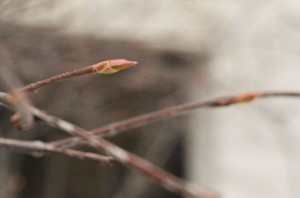Branching out to save Ottawa’s trees

Velta Tomsons, organizer of Tree Ottawa said trees need more protection from the city. © Sabrina Nemis.
The first snow of the season is a death sentence for the young trees that started budding mid-autumn. The unseasonably warm weather, in part due to climate change, has caused the trees to act at though it’s spring.
As Velta Tomsons walked down a snowy path through the trees across the canal from City Hall, she said it was likely this would prevent the trees from budding in the spring and they would probably die. This is particularly devastating because trees planted in Ottawa only have a life expectancy of seven years.
“Until we start planning for trees to live to 100 years, that’s not going to change,” said Tomsons, who works for Ecology Ottawa.
According to a 2006 report by city council on urban forest management, when trees are planted in Ottawa, they aren’t given enough space to mature. They are also affected by pollution in urban areas, especially from car exhaust.
The city also removed more than 15,000 ash trees between 2009 and 2015, in attempts to stop the emerald ash borer from spreading. The beetle lays its eggs in ash trees. The larvae hatch and eat their way out, killing the tree in the process.

The unseasonably warm weather this fall led to young trees budding as though it was spring. Those trees will not bud next year and could die.
While the world prepares to gather in Paris for the United Nations climate conference, the City of Ottawa is hosting a public meeting to plan local environmental strategy. On Monday, Prime Minister Justin Trudeau announced that Canada would commit to reducing carbon output and implementing sustainable practices. Protecting Ottawa trees will help the city’s sustainability. Its trees are particularly vulnerable because there are few protections for them in city policy and little bylaw enforcement.
“Trees don’t have any legal rights in our city,” said Tomsons.
Tonight at 6:30 p.m., the City of Ottawa is holding the first public consultation on its Urban Forest Management Plan. According to Philip van Wassenaer, an arborist and consultant helping the city with its forest strategy, tonight’s meeting has been set with the aim of sharing vision and goals, and getting suggestions from the public.
“While Ottawa has invested in successful tree-related programs, it does not have an overarching long-term vision for its urban forest to guide all stakeholders towards a common goal,” wrote Martha Copestake, the forester in charge of planning the Urban Forest Management Plan, in an email. While the city has had committees identify problems with forest management in the city, and initiatives to fight the emerald ash borer, there hasn’t been an official long-term strategy in place since 2003.
The city has created heritage tree bylaws that are supposed to protect trees greater than 10 centimetres in diameter. However, these bylaws are rarely enforced. Tomsons said there aren’t enough resources available to the forestry department to allow them to keep track of how many trees are in the city, where they’re located, or how big or old they are.
This is one of the recommendations she hopes to bring to the consultation tonight, as part of a proposal created by a taskforce of environmentally-minded individuals and organizations. Right now, Ecology Ottawa has a community-created map where people can add their own trees and “adopt” them, but it only has about 300 trees mapped.

The City of Ottawa is holding a public consultation tonight on their Urban Forest Management plan. It will be the first time the city has had strategy in place since 2003.
Tomsons is one of the many people working to protect trees in Ottawa. Trees have always been important to her—as a child she said there was a pine tree growing next to a huge black rock in her back yard that she would climb.
Until about two and half years ago did environmental education work for Haliburton Forests, spending plenty of time outside in the woods. Although she liked her job, she jumped at the chance to intern for Ecology Ottawa and take a more active role in river and tree protection.
“Trees do so much more than look pretty,” said Tomsons. She said they help filter pollution out of the air, they slow down storm water, easing the stress on city water filtration systems, they reduce carbon and decrease heat created within urban centres.
Tomsons and other people working to protect Ottawa’s trees can’t save this year’s young trees from being affected by the wide-reaching effects of climate change. However, they can work toward creating a strategy that will ensure current and future trees are protected from the more direct and immediate impact of citizens on our urban forest.
Those interested in attending the Urban Forest Management Plan consultation can learn more here: http://ottawa.ca/en/city-hall/public-consultations/environment/urban-forest-management-plan
